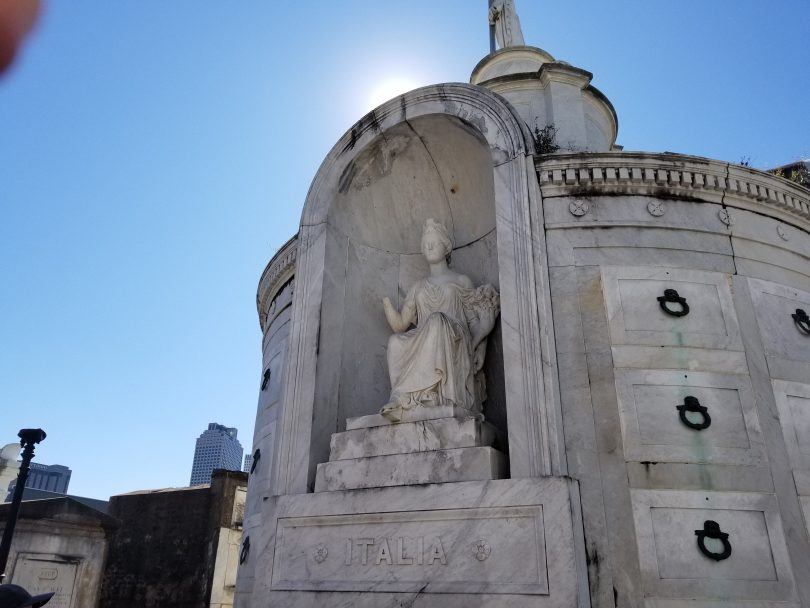New Orleanians have always had a cultural, if not sometimes morbid, fascination with death. One need only walk the streets of the city to hear the echos of tour guides telling ghost stories, or see French Quarter apartments for rent that boast “apartment is haunted” signs hanging from their galleries, to know that our relationship with death and the afterlife is a little different. After all, where else are cemeteries and the ornate tombs therein such a part of the fabric and architecture of everyday life?
It’s no surprise that we in New Orleans take our All Saints’ Day traditions very seriously. While people in other cities pull themselves from their hangovers and head into work the morning after Halloween festivities, New Orleanians travel en masse to the cemeteries to honor their loved ones and pay homage to those that came (and went) before them. Brought to New Orleans from France as La Toussaint, All Saints’ Day is celebrated on November 1 as a Holy Day of Obligation by Catholics who believe that the bond between the living and the dead is never broken and that, on this day, the souls of those we lost in the past year travel to the other side. It’s the duty of the living to honor those who have died with a yearly remembrance that includes prayer, dedication, the cleaning and whitewashing of the family plot or tomb, and leaving flowers, beads, prayer cards or other mementos to let the departed know that they were visited. Additionally, according to the Archdiocese of New Orleans, All Saints’ Day is dedicated to the saints of the Church; those who have been formally canonized and those who have yet to be recognized through canonization.
During the 19th century, All Saints’ Day traditions were more celebrated, with mobs of people crowding the cemeteries to honor the dead, and to pay their respects not only through tending to the tombs, but with a mass. Considered more than just a solemn day of observance, families would take the opportunity to get together and socialize.
According to New Orleans Catholic Cemeteries, in 1843 the Times-Picayune described the scene in the following way, “Repairing at rather a late hour to the Catholic Cemetery, we found a dense throng of people entering it, for which the gateway seemed vastly too confined, such were the numbers pressing in. Nor was there any distinction of colors, class, or nation. People of all hues and derivation, and of both sexes, were crowding for admittance; some to honor the departed, others to witness the singular observances. Entering the sad portals opening to the ‘house prepared for all the living,’ we found its long sad aisles, lined on either hand with their rows of crowded monuments-which are usually relieved in their glaring whiteness, only by a few scattered cypresses and willows-all hung with chaplets of fresh-plucked flowers, in every variety of form which taste can dictate.
Tapers were lighted around a thousand tombs, the glare of which paled before the clear light of day reflected from the whited sepulchers. There were thousands of faithful servants divided in small groups around each enclosure for the dead, some on bended knee, devoutly crossing themselves, or performing other rites, while others, in more cheerful mood, were arranging the flowers they had brought in more satisfactory forms, and discussing in pious rivalry, some point of taste as to the mode in which they should decorate the tomb of a departed master or mistress, or foster-child, or brother.”
Today, many local cemeteries hold blessings of the graves, as families gather to pay their respects. In the city of Lacombe, in St. Tammany Parish, the All Saints’ Day tradition not only includes whitewashing of family tombs, but illuminating them with candles, the idea being that the candles light the way for priests who walk through the cemeteries blessing the tombs. This is a tradition that goes back over 150 years and has its roots in the Creole and Choctaw culture. Kerri Bourgeois, who has family in Lacombe, remembers taking trips to the cemeteries as a child. “All Saints’ Day was the day we would pack up the car and drive down to St. Tammany and that area to pay our respects to my father’s family. We would always bring candles and flowers and make sure that the graves were neat and we’d eat out there and make a whole day of it. It was something we were all expected to do, no matter how old we got.”
This year, I plan on beginning my own tradition of visiting family graves in observance of All Saints’ Day. As someone who has had family in the city since the 18th century, my own ancestors are spread throughout the different cemeteries of the city, most notably my mother and maternal grandmother and grandfather in Greenwood Cemetery, my paternal grandmother in Lake Lawn Mausoleum, and my paternal grandfather in St. Louis Cemetery No. 1. I hope to carry on the tradition that citizens of the past started so many years ago and pass the remembrance on for years to come.
As in years past, Archbishop Aymond will celebrate the All Saints’ Day Mass at St. Louis Cemetery #3 at 11:00 a.m. and all are welcomed to attend.





